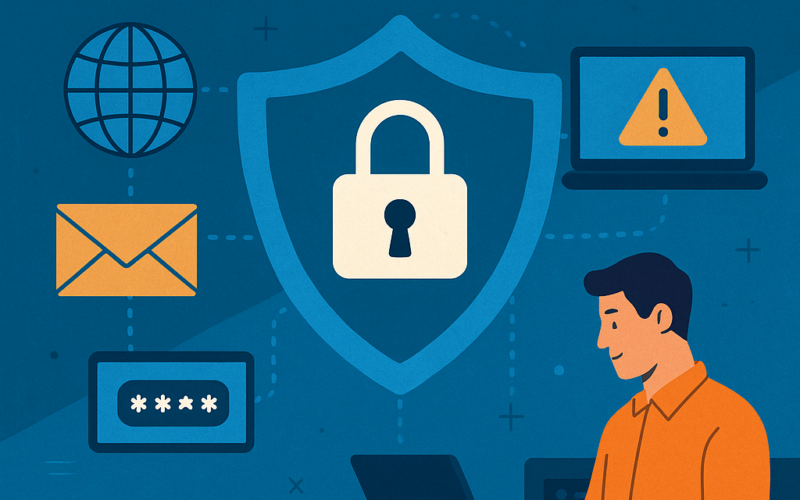Managed Service Providers (MSPs) play a critical role in maintaining the IT health of businesses, from small enterprises to large corporations. With the rise in cyberattacks and data breaches, cybersecurity for MSPs has never been more vital. MSPs are not just managing their clients’ networks—they’re also safeguarding sensitive data and ensuring compliance with industry regulations.
Unfortunately, their central role also makes them prime targets for cybercriminals. Attackers see MSPs as gateways to multiple networks and valuable data. That’s why robust cybersecurity isn’t a luxury—it’s a necessity.
Common Cyber Threats Targeting MSPs
MSPs are constantly under siege by a variety of threats. Here are the most common:
-
Ransomware: Encrypts client data and demands payment.
-
Phishing Attacks: Targets employees with deceptive emails.
-
Malware: Infects systems to steal data or cause disruption.
-
Insider Threats: Disgruntled or careless employees can expose vulnerabilities.
-
Credential Stuffing: Automated tools try known credentials across systems.
These threats evolve daily, requiring MSPs to stay ahead of the curve.
Understanding the Risk Landscape
MSPs must navigate a highly complex threat environment. The key risks include:
-
Multi-Tenant Vulnerabilities: One breach can affect multiple clients.
-
Remote Access Risks: Increasing remote work expands attack surfaces.
-
Third-Party App Exploits: Integrations can become weak links.
Understanding these threats allows MSPs to implement a proactive defense strategy.
Building a Cybersecurity-First Culture
A strong cybersecurity stance begins with a mindset shift:
-
Security Awareness Training: Educate staff and clients about phishing, password safety, and safe browsing.
-
Leadership Buy-In: Company leadership must champion security priorities.
-
Routine Drills: Practice responses to simulated cyberattacks.
This culture ensures everyone contributes to security.
Network Security Best Practices
Protecting the network is foundational. MSPs should implement:
-
Firewalls and IDS/IPS: To filter malicious traffic.
-
Zero Trust Architecture: Never trust, always verify.
-
Network Segmentation: Limits spread of attacks across systems.
These methods reduce risk and enhance visibility.
Endpoint Protection Strategies
Endpoints are often entry points for cyberattacks. Here’s how to secure them:
-
EDR Solutions: Provide real-time monitoring and automated response.
-
Patch Management: Keep software and OS up to date.
-
Device Encryption: Protects data in case of theft or loss.
These tools create a strong frontline defense.
Multi-Factor Authentication (MFA)
MFA significantly reduces unauthorized access:
-
Use for client portals, admin accounts, and remote desktops.
-
Tools like Duo Security, Google Authenticator, or Microsoft Authenticator are popular choices.
-
Enforce MFA across all critical services.
Secure Remote Access
Secure remote work is now essential:
-
VPNs: Encrypt internet connections.
-
Remote Desktop Protocol (RDP): Use cautiously with strict controls.
-
Privileged Access Management (PAM): Grants minimal access for specific tasks.
Security here ensures client operations remain safe, even offsite.
Data Backup and Recovery Planning
Every MSP should maintain a 3-2-1 backup strategy:
-
3 copies of data
-
2 different media types
-
1 offsite location
Ensure backups are tested regularly for integrity and speed of recovery.
Cloud Security for MSPs
With more businesses adopting cloud:
-
Configure SaaS settings securely
-
Use CASB (Cloud Access Security Broker) tools
-
Encrypt client data at rest and in transit
Cloud apps like Microsoft 365 or Google Workspace must be properly secured.
Compliance and Regulatory Requirements
MSPs often serve regulated industries like healthcare and finance. Stay compliant with:
-
HIPAA: Healthcare data protection
-
GDPR: Data privacy for EU residents
-
CMMC: Required for DoD contractors
Compliance helps avoid fines and builds trust.
Cybersecurity Frameworks for MSPs
Following frameworks improves structure and accountability:
-
NIST Cybersecurity Framework
-
Center for Internet Security (CIS) Controls
-
ISO/IEC 27001 Certification
These serve as best-practice blueprints for managing cyber risk.
Threat Detection and Response Systems
MSPs should deploy:
-
SIEM Tools: Aggregate logs and detect anomalies.
-
Managed SOC Services: 24/7 monitoring and response.
-
SOAR Platforms: Automate investigation and mitigation tasks.
These systems detect threats before they become incidents.
Incident Response Planning
A well-defined incident response plan includes:
-
Roles and Responsibilities: Who does what during a breach.
-
Communication Plan: Alert stakeholders quickly.
-
Post-Incident Review: Improve processes after each event.
Frequent tabletop exercises ensure readiness.
Vendor and Supply Chain Risk Management
Third-party vulnerabilities are common:
-
Perform Regular Security Audits
-
Use Vendor Risk Assessment Tools
-
Limit API Access and Integrations
Only trusted and verified vendors should access client networks.
Cyber Insurance for MSPs
Insurance helps mitigate financial fallout:
-
Covers ransomware, data loss, and legal fees
-
Evaluate coverage limits and policy exclusions
-
Partner with insurers experienced in MSP risk profiles
It’s a financial safety net worth considering.
FAQs About Cybersecurity for MSPs
Q1. Why are MSPs common targets for cyberattacks?
MSPs manage multiple client systems, making them gateways to several organizations at once.
Q2. What’s the most critical first step in MSP cybersecurity?
Implementing MFA and patch management immediately reduces common vulnerabilities.
Q3. How often should backups be tested?
At least quarterly, to ensure recovery readiness.
Q4. Can small MSPs afford enterprise-level security?
Yes, through MSP-focused platforms with tiered pricing and scalable models.
Q5. What regulations do MSPs commonly face?
HIPAA, GDPR, CMMC, and local data protection laws depending on client industries.
Q6. Are cyber insurance premiums high for MSPs?
They vary but are rising. Good security posture can help lower premiums.
Key Takeaways
Cybersecurity for MSPs is no longer optional—it’s a business imperative. From endpoint protection to incident response and compliance, every aspect contributes to a holistic defense. By following these 17 proven tips, MSPs can ensure their clients’ data stays secure while boosting their reputation and trustworthiness.








